The best robotics kits for beginners
It all starts with Lego.

By Signe Brewster
This post was done in partnership with Wirecutter. When readers choose to buy Wirecutter's independently chosen editorial picks, Wirecutter and Engadget may earn affiliate commission. Read the full guide to robotics kits for beginners.
When we tested robotics kits for beginners, the Lego Boost set won over the toughest critics: kids. And robotics pros, makers, and hobbyists agreed. With its Lego-based design, built-in sensors, and expansive options for creativity, the Boost kit was the most fun to build with. Plus, the tablet app's super-simple programming was the easiest to learn of any of the kits we tried.
Since it uses Lego pieces, the Lego Boost set is the most approachable and the easiest to figure out how to put together. It's a well-thought-out kit that a panel of child testers enjoyed as much as we did. The simple programming interface is easy to get started with, and the visual instructions allow non-readers to use and enjoy it, though more advanced programmers might find it limiting.
If our main pick is unavailable, the next-best option is the Ubtech Jimu Robot AstroBot Series: Cosmos Kit. The companion smartphone and tablet app that leads you through building and programming is the most organized and simple to learn of any we tried. The clear instructions offer a straightforward introduction to the popular Scratch programming language. The blocklike Jimu building pieces aren't as versatile as Legos, and they feel a little clunky, but they come together to build a capable robot.
If you're hungry to do as much as you can with a robotics kit, the Vex IQ Super Kit will satiate your appetite for new skills whereas simpler and less expensive kits may only be an appetizer. You can begin programming this kit with a graphical language or move up to more complex tasks using the C programming language, and the extra sensors—which can detect colors, for instance, or when the robot bumps into something—add possibilities that simple kits lack. The kit is made for educators, and as a result it has some of the most solid pieces and packaging.
Why you should trust us
When researching this guide, we interviewed three experts: Jenny Young, who owns the Brooklyn Robot Foundry makerspace; Marina Umaschi Bers, a professor of human development and computer science at Tufts University and chief scientist at KinderLab Robotics; and Andrew Terranova, a hobby roboticist who writes about robotics kits for Makemagazine. During a second round of testing, we also tasked three children ages 9 to 11 with programming four robots and picking their favorite.
I am a journalist who has spent the past five years writing about robots—including robotics kits. I've covered everything from kit announcements to a Lego robot battle, and in the process I've developed an understanding of who these kits are for and the range of what they can do. However, I'm not a regular user of robotics kits at home, so I approached this guide as a beginner builder and programmer.
Who should get this
A robotics kit should be of interest to any parent who wishes to encourage a child's interest in the STEM fields. Schools often turn to them to teach physics or math concepts, but at home they can also serve as a creative outlet and a source of fun.
Robotics kits are diverse in form and function. Some include a premade robot paired with an open-ended programming platform, while others meticulously walk you through building a humanoid construction (or a car or a spider or whatever the shape is). Some focus on teaching how to program for the Arduino open-source computer platform, while others use dead-simple commands to make the robot move.
Based on our expert interviews and our own experiences, we believe the best robotics kits for beginners challenge you to build and program a robot in an open-ended way. You start with the task of putting together hundreds of pieces—akin to working with a Lego set with the addition of functional parts such as motors and wheels. Then you program the robot to walk, talk, or play games. Kits should guide you through the entire process during the first build, and then reveal ways to get creative with original designs or programming applications. Children (or interested adults) should learn how motors can power wheels or legs, and should complete simplified programming tasks that build a foundation of programming knowledge, before moving on to more-difficult programming languages.
The best of these kits also appeal to adults with no prior programming experience. While the most feature-rich kits are generally designed for children between the ages of 8 and 15, they are often built to grow in complexity with the child's abilities. That means adults can find value as well—whatever their level.
Children or adults who are already used to working with more-advanced programming software (or who want to jump directly into that) are likely to find the kits in this guide too basic and restrictive. Although graphical-based programming is friendlier to beginners, it also boxes you into a specific way of doing things.
Adults who have no idea if their child will take an interest in robotics should avoid these kits as a first purchase, starting instead with an inexpensive (and less capable) option such as the Insectbot Hexa or 4M Table Top Robot. That way you don't drop $150 on a kit that they quickly abandon due to disinterest or frustration. Adults should also be ready to step in and help their child at appropriate points, as some parts of building and programming a robot can be intimidating to an unsure child.
All of the robotics kits we tried require a computer or a mobile device to program the robot, so you should also make sure that the companion software is compatible with your device.
How we picked
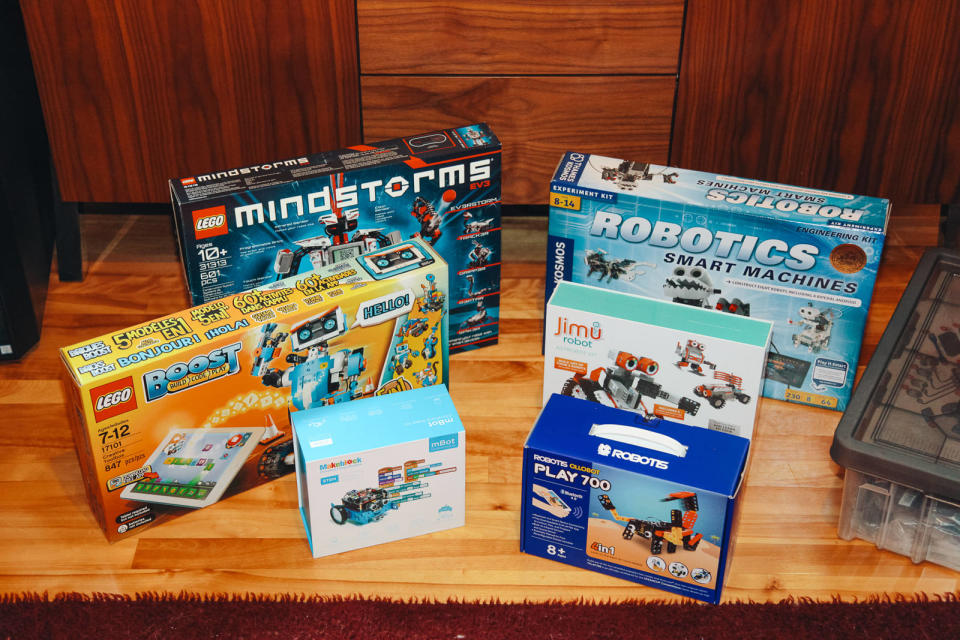
To choose which beginner robotics kits to test, we scoured websites like Amazon for reviews and considered existing guides from publications such as Tom's Guide and Make. We also consulted our experts on the most important functions to get out of an introductory robotics kit. We used the following criteria to narrow down our list; we ended up with seven kits to test initially, and an additional four for our most recent update.
Build and program: We excluded any kits that focused solely on building or programming in favor of options that included both.
A complete package: Everything you need to build and program the robot should be contained in the box (though you will need to provide your own tablet, phone, or computer).
Excellent instructions: The directions should include a step-by-step guide to building an example robot or two, plus all the guidance a beginner needs to program the robot. This information might be provided via an instruction booklet or an app—the medium isn't too important as long as the instructions are thorough.
Open-ended structure: You can build a variety of example robots, plus designs you invent yourself.
Graphical programming software: A beginner without prior programming experience should feel comfortable jumping right in, thanks to a drag-and-drop interface or a similar programming environment.
Expandability: If you want to build more models with your kit, extra parts or expansion packs should be available for purchase.
A reasonable price: We found robotics kits available at just about any price. The cheapest kits tend to be singular in their purpose, reducing their long-term appeal. The most expensive kits, which can cost $1,000 or even more, are better suited to advanced programmers. We determined that paying roughly $85 to $300 would get you all of the ideal features in a beginner robotics kit.
How we tested
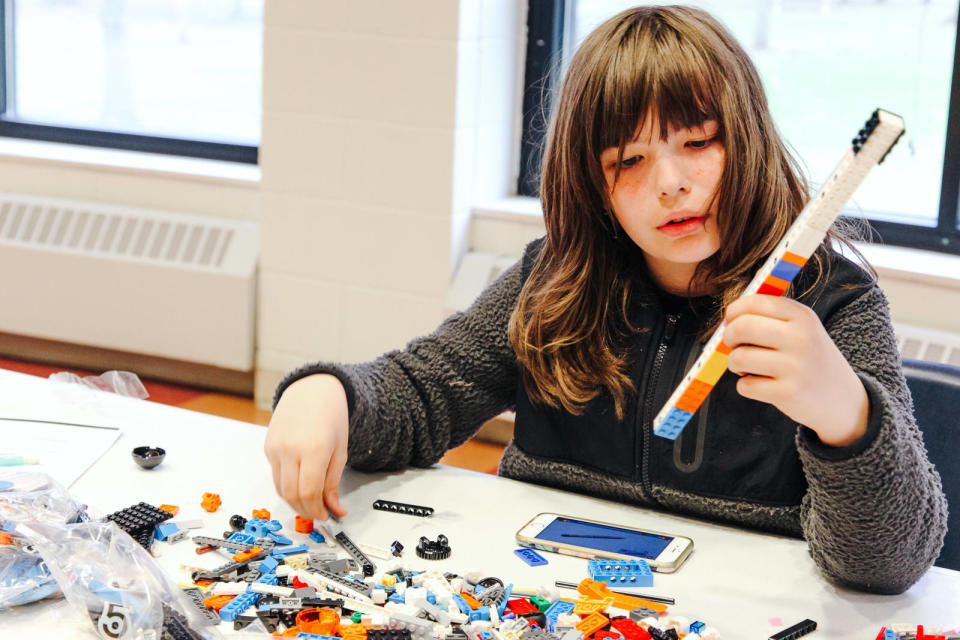
For each kit, we began by following the included instructions to build one of the suggested models. We timed the building process, and we decided that build times from 1½ to 2 hours were the most enjoyable for completing a project in a single sitting. (The 11 kits we tested took anywhere from 32 minutes to 2 hours, 38 minutes to assemble.) We also made note of the durability of the pieces and examined the thoroughness and clarity of the instructions. Most important, we considered how much fun we had building the kit. Some kits made creative play easy, with suggested further projects and accessories to personalize the robot. Others had flaws such as difficult-to-attach pieces or boring appearances that took away from the overall experience.
Next came the programming stage. We downloaded the required smartphone or tablet app or desktop software to program each robot and then went through the steps to build a basic program. We considered the difficulty level of each coding language and whether it could satisfy builders both young and old. While some apps seamlessly took us from the building stage to the programming stage, others were more difficult to grasp but allowed for more advanced programming.
For our initial round of testing in 2017, we tried seven robotics kits. In 2019, we tested four new kits against our top pick, the Lego Boost set. Our second round of testing included three kids ages 9 to 11. They spent 20 minutes programming, playing with, and breaking four robots that had been assembled in advance. The kids received no assistance from their parents, though they occasionally asked me for help.
Our pick: Lego Boost
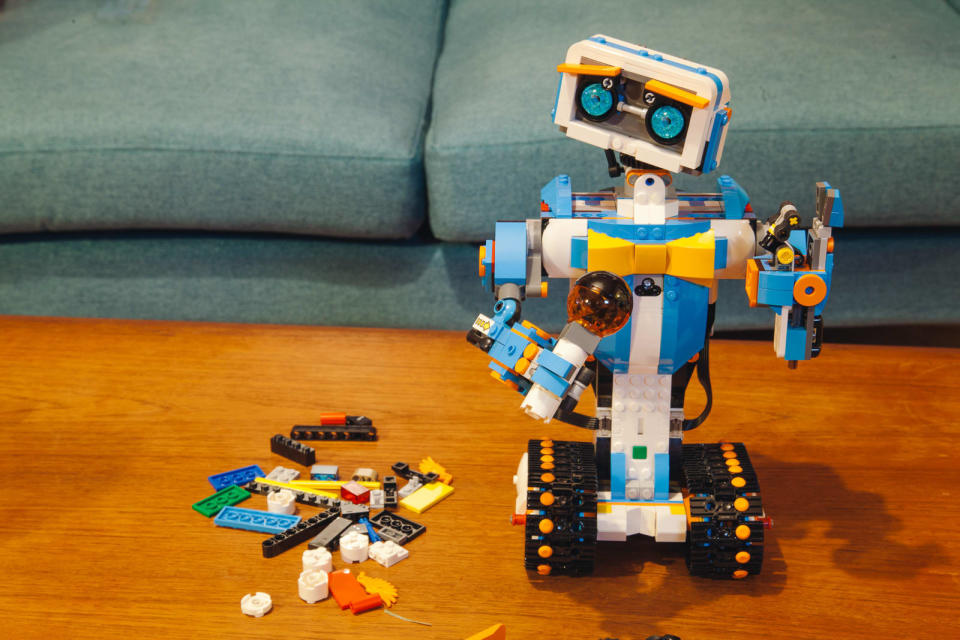
The Lego Boost robotics kit offers the best overall experience for those with no programming experience who want to start building robots. The 847-piece kit consists of Lego pieces, so it's the most fun and the easiest to build among kits of its size, thanks to Lego's familiarity and versatility. The instructions for building and programming the robot come in a simple tablet app that even non-readers can follow. Its programmable sensors can detect movement, distance, and color. And the fact that the kit is Lego-based and any Lego block can work in a project means you have a massive opportunity for expansion right out of the box. In contrast, you can extend Lego's own Mindstorms kits using Lego's Technics simple machine parts, but doing so is a lot more complex and expensive.
To test the building experience, we put together a humanoid robot called Vernie, which took just under two hours—right at the sweet spot for the most enjoyable amount of build time.

The Lego Boost app is compatible with a wide range of devices; you can find a full lineup on the Lego website. The app lays out building and programming instructions in an integrated curriculum. On the main screen, you begin by tapping an image of the robot you wish to build. Five suggested builds—Vernie the humanoid, a cat, a rover, a building machine, and a guitar—are included. These five amount to more than eight hours of guided building, which is on the higher end of the kits we tested; you're less likely to get bored with this kit than with others that include fewer projects.

We found the Boost kit's instructions for building the robot the easiest to follow of the kits we tested. The app walked us through the steps to build Vernie piece by piece, which minimized the chances of our skipping steps and making mistakes. The standard Lego pieces are easy to work with and tough enough to withstand repeated use—other kits we tested were difficult to snap together, and some had pieces that seemed flimsy. As with standard Lego sets, the Boost pieces come grouped in numbered bags, making them especially easy to find at the right time. However, if you want to preserve this system for subsequent builds, you have to place the pieces back in the right bag every time you take a build apart.
One drawback of piece-by-piece instructions is that they don't build a deep understanding of how the robot works mechanically. Instead, the focus of the Boost set is to make it easy to customize any of the five suggested builds. After we completed Vernie, the app offered us different options for add-on builds plus related programming challenges. The number and creativity of the add-ons were unmatched among the other kits we tried, which for the most part had only enough pieces to construct the guided robot builds. Lego's more-expensive Mindstorms kit does offer add-ons, but not as many, while Vex's robot comes with some extra functional sensors.
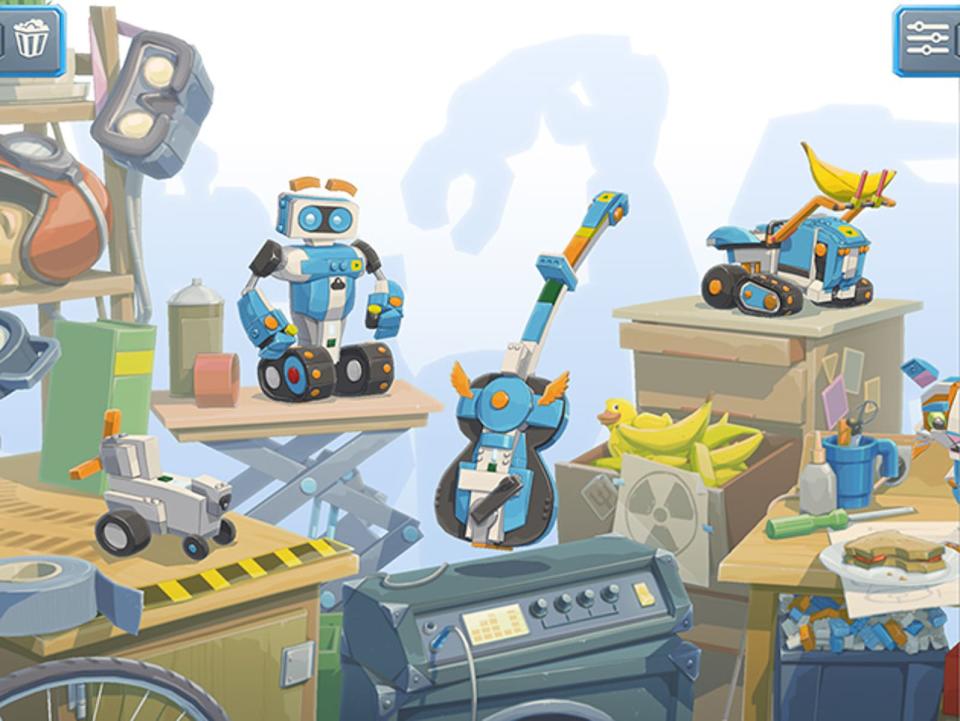
We made Vernie a bow tie and microphone, which unlocked programming options to make the robot sing and dance. More advanced builds, such as the cat and the guitar, unlock more sophisticated abilities for the kit's sensors. For example, you can build a mobile robot that avoids obstacles, or one that senses the location of fingers to make a Lego guitar playable. If you care more about building than programming a robot, the Boost kit might be for you—it's the best at packing a lot of satisfying projects into one kit.

As we progressed through the Boost app's building instructions and our robot came together, the app interjected short programming challenges for teaching the basics of controlling Vernie. Beginning to program the robot before it is completely built is an effective way to learn the function of each part of the robot, and which commands control what. Other robotics kits wait to introduce programming until after you've built the robot, an approach that doesn't always illustrate what commands are connected to which motors, sensors, or other robot parts.
Lego's programming language is completely graphical, which means that each command is represented by a symbol. From the main library of symbols, you can drag and drop each to create a sequence. Lego states that Boost is appropriate for ages 7 to 12, a range that's on the younger side of the kits we tested. Although the Boost app doesn't offer the fine-tuned programming options of more advanced software, you can still make the robot roll across the floor, dance, and sing. It's enough to provide hours of fun for anyone who is just looking to play with a robot.
Flaws but not dealbreakers
The Lego Boost kit is specifically aimed at beginners, so its capabilities are not as advanced as those of some of the other kits we tested. While Vernie has cute expressive eyebrows, functional treads for moving around, and a few controllable joints, the robot can't pick up objects or do as wide a variety of sensing as others we tested.
The same applies to the Lego Boost app, which is streamlined to a fault. It's not easy to just jump in and play around with programming your robot. Instead, different groups of programming abilities appear within the building instructions as you progress. After you unlock new programming challenges (certain parts of the app are locked until you graduate to harder skills) while building, you have to skip around to find the programming options you want. One of our child testers noted that he found it frustrating he couldn't skip ahead to another activity when he grew bored of the current lesson in the Boost app.
The programming environment is also ultra-simplified. Graphical programming is meant to be accessible to anyone, and it's clear Lego wanted to build software that even non-readers could use. But reducing each programming command to a symbol sometimes gets confusing: It's not clear what each symbol means, and it takes some practice to learn each symbol's purpose and how it can apply to the robot. We wish the app did a more comprehensive job of explaining how to use each command.
If you have ever used Legos, you're probably familiar with that feeling of hunting through a large pile of bricks for the one tiny piece you need. All of the Boost pieces come in numbered bags that simplify your first build, but once you take it apart the pieces get jumbled together. Panelists such as 11-year-old Za'im noted that it was very hard to find each piece the Boost app mentioned. It's a good idea to develop an organizational system.
Lego will discontinue its Windows software for Boost in January 2020, which means you need a mobile device to program any robot you build (the app isn't available for Macs, either). Although it's possible to find online PDF instructions for building the robot, Lego Boost kits are made to be programmed from a tablet (though many smartphones are a more cramped possibility). People who don't have a tablet should avoid buying the Lego Boost kit.
Runner-up: Ubtech Jimu Robot AstroBot Series: Cosmos Kit

If the Lego Boost kit is unavailable, we recommend Ubtech's Jimu Robot AstroBot Series: Cosmos Kit. Its app has the best programming interface of any we tested, and you can choose to build and program the robot in a "story" mode, which adds a plot to teach the basics of the robots and how each piece of hardware needs to be programmed. However, we didn't like building with the interlocking Jimu cubes as much as we liked building with Legos, and the Cosmos Kit comes with instructions for fewer robots.

Like the Lego Boost app, the Jimu app walks you through the build process piece by piece. The 400-piece Cosmos Kit mostly consists of cubes that slide together. While it can be tricky to get the orientations just right, the app shows a 3D model of the build that you can rotate to make sure you know what to do. It also offers hints at particularly tricky points.
Eight of the 11 robotics kits we tested have you use small pegs to attach components. Mounting the nonblock components of the Cosmos robot—such as its treads and hands—requires the use of these pegs, which are more difficult for small hands to assemble. (They also have a tendency to roll away and get lost, so we recommend storing them in baggies or bowls.) Also, due to Cosmos's extra features, such as its expressive eyes and grippy hands, you need more wires to attach different parts of the robot—the one mistake we made while building was mixing up which length of wire went where.
Cosmos really shines when you get to the programming stage. After we completed the build, we moved into another part of the app that allowed us to start programming Cosmos using a language based on Scratch. The benefit of using Scratch is the massive amount of documentation and educational materials available online thanks to Scratch's large and devoted community. Of the kits we tested that offered Scratch-like programming options, we found the Jimu tablet version to offer the best combination of ease of use and ability. The library of commands is organized and a snap to navigate: You combine commands by dragging and dropping on the tablet's screen. Chase, a 9-year-old test panelist, noted that each module had a clear purpose due to the use of words—no cryptic symbols (as you see in the Boost app) here.
The Jimu app makes it easy to quickly understand the robot's abilities and provides some inspiration for further programming by offering some predesigned commands: When you first enter the programming app, you can tap a command such as Clap or Sleep. Cosmos looks like Wall-E, and its programmable eyes and arms make it the most expressive robot we brought to life. That made digging into the programming possibilities especially exciting.
We tested two other Jimu robotics kits: UnicornBot and BuilderBots. We think all three are great options; if your child is especially fond of space, unicorns, or construction equipment, go with the kit that best matches their interest. You can read more about the UnicornBot and BuilderBots sets in the Competition section.
Upgrade pick: Vex IQ Super Kit

For roughly twice the price of the Lego Boost kit, the Vex IQ Super Kit gives you more advanced building and programming features that will be appealing if you want to get deeper into robotics. The kit is designed for educators, so it comes with a lot of helpful documentation and suggested uses that are better suited to experienced robot builders and programmers. Thanks to the more mature aesthetic and instructions, older kids will feel like this kit is designed especially for them. It may also be more appealing to adults new to robot building.
Offering 850-plus pieces, this Vex kit has almost the same number of pieces as the Lego Boost kit, and it comes in a tough plastic box that has a tray for holding small pieces. This is the most elegant packaging we've come across for keeping everything organized and safe—good news if you're planning to use the kit often.
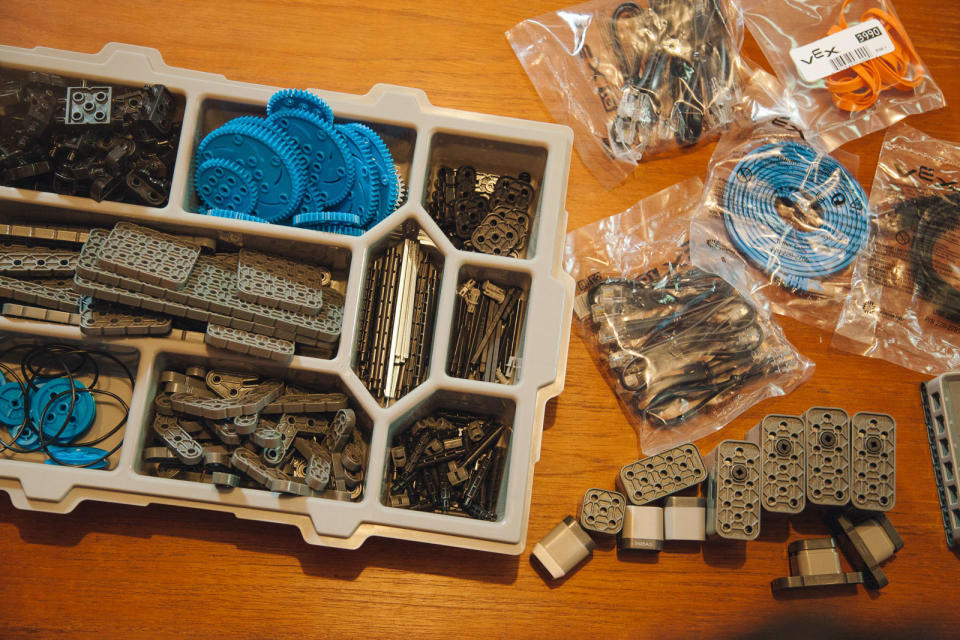
The Vex website has 10 suggested builds for the kit. We chose to build the Clawbot—a wheeled robot with grippers—depicted in the included instruction booklet. (The Vex website also offers animated instructions for the Clawbot robot, but for none of the other builds.) Vex provides a lot of context, including textual explanations of different build steps and the purpose of each included sensor, which helps you understand what's going on as you progress. You come out of the process knowledgeable about the name and explicit purpose of each part of the robot, something we can't say is true with the Lego Boost set. (Before choosing a build, we suggest researching the options online, as the builds have different abilities.)

Unlike Lego Boost's simple instructions, each step of the Super Kit's instructions covers combining several pieces, making the directions more difficult to follow. The kit also has lots of similar-looking but slightly different pieces, so it's important to use the included reference sheet of full-scale labeled images to determine which piece is which. The instructions include an option to add programmable sensors, which have the most advanced capabilities of any robot sensors we tested. One sensor acts as an obstacle-detecting bumper so the robot won't run into walls. Another can detect the robot's speed and turn rate, giving it the ability to make exact, 90-degree turns. Other sensors can detect color and distance.
Once you get to the programming stage, Vex offers a suite of options, including an iPad app and desktop options for Scratch or C-based coding (which we used in testing; we didn't test on the iPad). We thought that there was more of a learning curve to start programming this robot than there was with the other options: Desktop-based Scratch applications look and feel more complicated than the simpler tablet apps that accompany another kits, and C-based programming brings a step up in complexity. The kit also comes with a game pad for quickly jumping into controlling the robot. The other kits that include direct remote-control functions offer them only via virtual buttons on a tablet screen.
The pieces of the Vex kit are difficult to snap together. Our hands felt beat up by the end of the build process; that might be a problem for children and adults with weaker hands.
The competition

Lego Mindstorms is a popular robotics kit for a reason. It offers lots of programming options and has fun accessories for building new abilities into the robot. You can also expand it with Lego Technics, so it's one of the most versatile kits available. However, it doesn't offer as streamlined a build or programming experience as Lego Boost does. If you're looking for a more advanced kit, we like the sensors and builds included in the Vex IQ Super Kit better.
The Robotis Ollobot Play 700 set was once our budget pick, but now it costs nearly as much as the Jimu line of robots. While the Ollobot Play 700 kit offers one of the widest ranges of programming options, allowing you to progress through multiple levels of difficulty, we still think the Jimu robots are more fun to build and program.
With its light-up horn and purple mane, Ubtech's Jimu Robot Mythical Series: UnicornBot Kit could be a nice alternative to the Cosmos Kit for a kid who is obsessed with unicorns. Like the Cosmos set, it comes with our favorite app for building and programming the robot, though it doesn't come with the Cosmos set's storytelling mode. However, it's limited to instructions for building the one unicorn shape; we preferred kits with more flexibility for trying different builds. We also find that unlike Lego Boost, the Jimu kits feel especially gendered; girls gravitated toward the UnicornBot, while boys identified it as "girly" or "young" (one boy then launched into an explanation of how difficult it was to overcome gender norms at his age). To us, the Cosmos Kit seems the least gendered of the three Jimu kits, but follow your gut on what your child would like best.
Similarly, the Jimu Robot BuilderBots Kit could appeal to a child who is interested in construction equipment. It comes with instructions to build vehicles that grab, scoop, and dig, which makes the robot feel more interactive. It also uses our preferred Jimu app for building and programming but doesn't have the same storytelling mode as the Cosmos Kit. "It just looks like a comedic relief character," 11-year-old Niko said during testing.
The Makeblock mBot is made up of tough, metal parts. But unlike the other kits we tried, this set doesn't come with multiple build options (though you can buy add-ons). It was a favorite of one of our experts, but it didn't feel as creative or as fun to work with in our testing. Its programming options also weren't as intuitive.
The Meccano MeccaSpider looks so impressive that one of our child testers called it their favorite robot. But neither we nor our child testers could get the app to work reliably—the robot seemed to do as it pleased and marched in circles instead of listening to our attempts at control. Programming wasn't intuitive, either. The spider does have the ability to spit water, though some parents might not see that as a bonus.
The instructions for the Thames & Kosmos Robotics Smart Machines kit provide some useful context before you start building, and the set comes with a nice-looking app, but we found it to be the most frustrating kit to put together. The instructions were confusing sometimes, the pieces didn't always fit together well, and some parts broke during the build process.
This guide may have been updated by Wirecutter. To see the current recommendation, please go here.
When readers choose to buy Wirecutter's independently chosen editorial picks, Wirecutter and Engadget may earn affiliate commissions.
